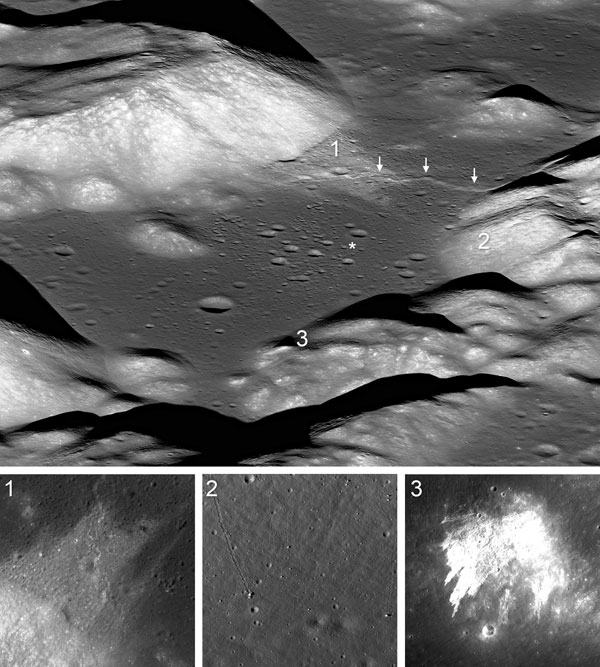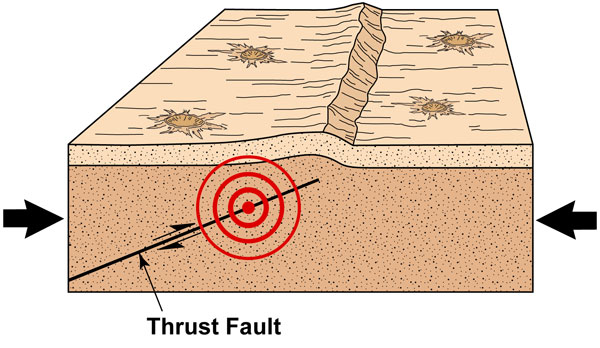A new look at old seismic data gathered during the Apollo missions reveals young active faults as a possible origin of shallow moonquakes.
Did you know that the Moon quakes?
When the Apollo astronauts deployed seismometers, they revealed that the Moon quivers and shakes in many ways. Between 1969 and 1977, these instruments picked up all kinds of vibrations, most of which were linked to meteor strikes, tidal forces, and thermal changes. But there were also 28 shallow, but surprisingly powerful quakes of unknown origin. According to a new study appearing online May 13th in the journal Nature Geoscience, those shallow quakes could be linked to current tectonic activity on the Moon.

NASA / GSFC / Arizona State Univ. / Smithsonian
The presence of tectonic activity doesn’t mean that the Moon has plate tectonics — its crust isn’t broken into a patchwork of moving plates like Earth’s crust is. Instead the Moon, like most rocky bodies in the solar system, has a single plate that covers its whole surface. On Earth, the inevitable loss of heat from the interior drives its plates’ movements, but it’s a different story on these one-plate worlds: They contract as they cool down, forcing their rigid crusts to adjust. The Moon’s surface wrinkles as it’s compressed, forming thrust faults when the crust breaks. One side of the break slips downward while the other side goes upward, a process that creates telltale steep slopes, or scarps, across the Moon that are typically tens of meters high.

Arizona State Univ. / Smithsonian
Researchers have used a computer algorithm to analyze Apollo-era seismic data, improving the estimated locations for the shallow quakes’ epicenters. Their analysis has revealed a possible source for these tremors: They seem to be linked to the network of fault scarps that litter the lunar surface. At least eight of the quakes’ centers lie within 30 kilometers of one of these fault scarps.
Even though these faults cover most of the lunar surface, they had gone largely undetected until 2010, when NASA’s Lunar Reconnaissance Orbiter (LRO) started systematically mapping the surface at high resolution.
But while these features required advanced technology to see from orbit, they’re easily visible from the ground. For example, the Lee-Lincoln Scarp, which is very close to Apollo 17’s landing site, can be seen in many of the pictures taken by Cernan and Schmidt. “When you are looking down the valley you can see what looks like a wall — it’s like a stair step in the topography,” says the study’s lead author Thomas Watters (Smithsonian Institution, Washington). “It’s not like you are going to walk over one of them and not notice it, there’s tens of meters of leap.”
By counting superimposed craters as well as estimating the time it takes for these features to erode, Watters and his colleagues estimate that the scarps are probably younger than 50 million years old. But are the faults they’re associated with still active today? A key clue can be found in looking at what point in the Moon’s orbit the Apollo quakes happened.
The researchers realized that 18 of the 28 shallow shakes occurred close to the lunar apogee, when the Moon’s elliptical orbit takes it farthest from Earth. Faults tend to slip and cause tremors during moments of peak tension, and the tidal stress caused by Earth’s gravity peaks during apogee. While that might seem counterintuitive, Earth’s gravitational pull is distributed over a smaller cross-section of the Moon’s surface when the Moon is farther away.
“A lot of people understand that the Moon creates tides on Earth,” Watters explains, “but they don’t realize that Earth is doing the same thing to the Moon, only here it is the solid body that is flexing, rather than the ocean.”
Once Watters and his colleagues realized that the tremors occurred more often during apogee, they used a computer algorithm specially designed for sparse seismometer networks to see if the quake epicenters were associated with the faults. It wasn’t easy: There were four seismometers on the Moon, but they were all located on the nearside and in the same narrow equatorial band where the Apollo missions landed. Also, they weren’t as precise as modern seismometers. “We are talking 60’s technology here,” Watters notes. “That wasn’t accurate enough to be able to pinpoint with confidence the location of the epicenter.”
“We realized we weren’t going to be so lucky as to get a bull’s eye, even with the best performance of this algorithm and the quality of the data,” Watters explains. For that reason, the team was satisfied to find that 8 of the 28 shallow moonquakes occurred within 30 kilometers of the faults. Six of these eight also happened around lunar apogee.
Brigitte Knapmeyer-Endrun (University of Cologne, Germany), who was not involved with the current study, agrees the result is statistically significant. She highlights the importance of modern-day computing to take a full account of the data. “This is certainly more than could be done in the 1970s, when digital signal processing was in its infancy,” she adds.
If the researchers are right, these results show that the Moon is still tectonically active more than 4 billion years after its formation. This understanding could have practical implications for future exploration. We now know that the Moon is full of active faults that can produce four or five surface quakes every year. According to Watters, planners of future missions to the moon will probably need to consider this if they intend to build permanent structures in the lunar surface. “You don’t really want to be very close to these things; even 30 km is maybe too close, because our model shows that there is where you are going to get some strong seismic shaking,” Watters said. “I’m hopeful that this will support the notion that we need a modern geophysical network in the Moon.”
 1
1









Comments
fif52
May 15, 2019 at 6:11 pm
Moon colonization by 2024, they should have further data if they intend on building structures there. These could be made there if plans are to be believed, bring the machines but getting the materials there. Are all these images of recent events? The boulders? The darker areas?
You must be logged in to post a comment.
You must be logged in to post a comment.